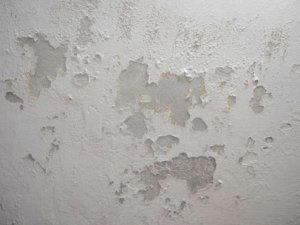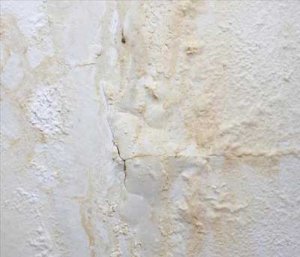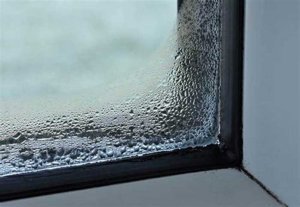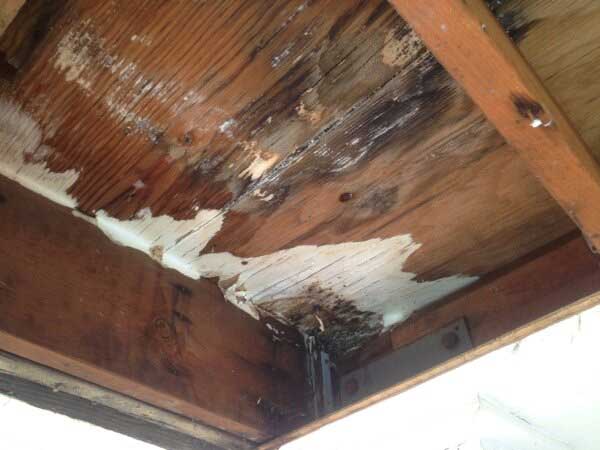Most common signs & problems caused by excessive humidity you will notice are listed below. And you will likely need a dehumidifier to resolve excessive humidity.
However, you maybe able to resolve some of humidity issues by taking measures such as improving ventilation or adding house plants as noted under each sub heading and these are options to resolve humidity issues without a dehumidifier.
It is important to maintain optimal humidity levels between 40% to 60% as the excessive humidity can cause damages to the property and your health.
Some of the signs are very obvious and visible to naked eye. However, you can also use a tool called hygrometer to determine current levels of humidity.
Higher humidity levels are usually experienced during the summer months and if you live near lake or sea.
1. Musty Odors
Everyone wants their house to smell fresh at all times. However, if your home has mold growth due to higher humidity levels you may experience following:
- Musty smell emanating from areas that have been affected by mold and bacteria growth.
- Continues growth of mold in the house.
- Damages to the property and health.
Resolve This Issue: Musty odors can be removed by improving current ventilation, removing and cleaning items that have been affected by mold.
You can also add house plants like peace lily to help reduce humidity. For extreme measures use a dehumidifier to reduce indoor humidity levels and prevent further spread and growth of mold and bacteria.
Also, make sure to run ventilation fan in the washroom after each shower for few mins to remove all the humidity build up.
2. Peeling Paint or Wallpapers
Wallpapers and paints aren’t designed to last forever regardless of maintaining proper levels of humidity in a home. Excessive humidity causes following based on our experiance:
- You will notice peeling, cracking or blistering wallpapers and paint caused by loss of adhesion.
- Paint blisters occur when moisture gets trapped between the paint and the wall, particularly when a house is exposed to excess humidity for a prolonged period.

Resolve This Issue: Depending on the humidity level this can be resolved by improving ventilation however, using a dehumidifier can resolve it.
3. Visible Water Stains
Water stains that gradually start to develop mold are one of the visible sign of excess humidity in a home. Water stains appears as dark patch on the wall usually on the corners as they start to develop.
Since, mold can thrive just about anywhere provided that there is moisture and nutrients. This includes on the walls, ceilings, in the bathroom, near windows or even on the furniture and upholstery we will discuss in next how and where mold will develop due to excess humidity.

Resolve This Issue: Clean water staining with general stain removers and increase ventilation or introduce dehumidifier to resolve this issue.
4. Mold on Walls and Ceilings
Due to excessive humidity causing water build up on the wall and ceiling resulting in staining will eventually cause mold and bacteria growth. As discussed, mold can grow as long as there is moisture and nutrients available.
Looking closely on the wall if you see dark blackish spots or line that means you potentially have mold growth.
Resolve This Issue: Mold fungus will often attack drywall, which is largely comprised of cellulose. If this has happened you will need to remove the portion of the drywall. And to further ensure no humidity is develop and use dehumidifier to maintain optimal humidity in your home.
Generally on the ceiling if you have mold growth, make sure to check for water leaks from roof or above ceiling levels.
House plants like English Ivy are great natural way decrease growth mold and humid air.

Mold in the Bathroom
Vapor has a tendency to rise upwards, and because of daily showers, bathrooms are prone to mold development.
Due to hot, humid air that cannot escape from the bathroom, it leads to the accumulation of moisture and forms an ideal growth environment for the mold and bacteria.
Mold in the bathroom often manifests by the darkening of the grout between the shower tiles, which is unsightly, to say the least.
Leaky toilets and burst plumbing pipes are also common culprits for excess humidity in bathrooms. Apart from the walls and ceilings, excess moisture in a bathroom will also manifest through mold growth on cellulose materials like rugs, wallpaper, fabric, and grout.
Resolve This Issue: The best way to prevent mold growth in bathrooms is to keep the moisture levels in check. Also, make sure to run exhaust fan for 30 mins after each shower.
If unable to reduce humidity to normal levels it would be important to install a small dehumidifier.
Mold on the Window Frames
It’s not unusual to find condensation forming on windows, which is attributable to the cold outdoor air that cools the glass to form moisture. The so formed moisture will often run onto the window frames, creating a conducive environment for mold growth.
Resolve This Issue: Make sure to keep your window glass clear of water and you must add a high power dehumidifier to remove excess humidity because window replacement are not cheap.
Mold in the Basement
Basements are the most susceptible to mold infestation. This is because the basement is usually damp from pipe leaks or high level of underground water. Basements also experience a lot of condensation, and the majority of the basements are poorly ventilated. Such dampness causes mold to develop on the building structure located in the basement, thus weakening the structural integrity of the home.
Basements are also prone to getting extra-humid from seeping underground water. This is a commonly recurring problem especially in homes constructed over historical riverbeds or close to a large water body such as a dam or a lake. Basements also become extra moist if they have inadequate weeping tiles or cracked concrete.
Resolve This Issue: From our experience to keep basements dry use one of the following suitable dehumidifiers.
- WARNING: If you detects moisture trickling out of the basement walls, and/or water pooling on the floor, or very damp/humid air, and/or musty odor, it is possible that your basement is dealing with an extreme case of water damage. We recommend to engage professional assistance to repair the basement wall i.e. damp proof it and clean up the basement in addition to investing in a suitable basement dehumidifier to help reduce the excess moisture.
5. Condensation on Windows and Doors
Condensation occurs when warm moist air comes into contact with cooler surfaces. If you find condensation build up in the interior parts of the windows, i.e. water beads and fog, these are signs of excess moisture but this is common during the winter time and does not mean you have excessive humidity. You will need to confirm it using hygrometer what level of humidity you have and if it conforms to the optimal humidity levels.
- Excessive indoor moisture can be caused by a variety of factors including cooking, showering, installing fish tanks, drying clothes with the dryer, and even breathing.
- Outdoor climate, when it rains for a few days non-stop or when the locale experiences high humidity, can cause excess indoor humidity.

Resolve This Issue: While occasional condensation on the window and door panes isn’t much of a problem, and proper ventilation can resolve this. To keep the humidity levels in check, we would suggest you must place fully functional dehumidifier in rooms that are most affected by condensation.
Also, you can add spider plant which is very effective in removing harmful air pollutants.
6. Structural Issues
When wood is exposed to excess humidity over time, it begins to rot. Wood decay is caused by fungi after it breaks down the cellulose and hemicellulose, the vital components giving wooden structures their strength and resilience. Rotten furniture, window and door frames and floors are often indicative of too much moisture.

Based on our experience we have noticed following to the wood products around home:
- Upon decaying, wood is becomes weak and brittle and likely to appear bulky. The wood will also appear sunken or shrunken in addition to having dark spots and cracks on its surface.
- Moist wood tends to swell and warp, which is particularly detrimental when it comes to wood flooring; these are extremely responsive to changes in indoor humidity levels. For instance, wood flooring are supposed to stay flat and smooth, but when exposed to excess moisture, they start to swell, separate, crack and stain in addition to becoming loose.
- Too much moisture causes the wood in the ceilings, floors, and walls to rot, which can even compromise the structure of a home.
Resolve This Issue: We recommend to take steps towards extracting the extra moisture from their indoor environment to protect the structural integrity of their property. i.e. increase ventilation and installing dehumidifier(s).
7. High Body Temperatures
How the body regulates temperature and how this process is affected by humidity as per Canadian Center for Occupational Health & Safety.
During elevated temperatures, the body initiates a mechanism that helps to keep its internal temperature optimal; sweating. When the sweat evaporates, it takes with it a certain amount of heat. However, if the surrounding environment is already saturated with too much moisture, the sweat won’t evaporate. In turn, a person ends up feeling hotter and stickier.
Consequently, the body resorts to the next best solution, which is rapid breathing. The heart also begins to beat faster than usual, thereby increasing blood pressure. After some time, a person may begin to feel sluggish, confused, lightheaded, or even lose consciousness. Ultimately, if the body can’t maintain the ideal temperature, a person may develop heat exhaustion.
Resolve This Issue: We suggest you use a dehumidifier in conjunction with air conditioner during summer when there are excessive heat and moisture in the air. The dehumidifier will get rid of the indoor moisture, thus enabling the body to cool off through sweating.
8. Increased Health Complications
Too much moisture has some indirect effects that carry grave consequences. It can facilitate the growth of dust mites, mold and bacteria. And that can produce spores that often cause allergic reactions and respiratory issues.
Prolonged exposure to these contaminants leads to various health complications, some of which are discussed below:
-
Asthmatic Reactions and Complications In the Respiratory System
Mold and dust mites are known to exacerbate respiratory conditions such as asthma. They also trigger hypersensitivity for people who don’t have asthma. When people inhale mold spores and waste from dust mites, they suffer symptoms such as frequent sneezing, as well as the itchy, runny, or congested nose.
When too much of these pollutants have been inhaled, and they manage to reach the lungs, they may cause a gradual worsening of asthma.
-
Allergic Reactions
Besides asthmatic reactions, both mold and dust mites also lead to allergic reactions. These include itchy eyes, irritation in the ear canals, hives on the skin, swollen eyelids, throat irritation, and coughing.
-
Effects Of Chemical Contaminants
Besides these natural contaminants, airborne volatile organic compounds like formaldehyde that’s found in furniture among other wood products may also cause adverse health effects like irritation of the skin, eyes, and throat. In extreme cases, people may also experience respiratory issues like sneezing, nose irritation, and difficulties in breathing.
The release of these elements into the indoor air occurs when chemicals found in the furniture and building materials react with water vapor.
What to do about it: We suggest, whenever you experience any of the above health symptoms, you need to consult with a doctor to receive treatment. You should also invest in a dehumidifier to curb the excess moisture, ensuring that it remains between 40 and 60 percent. and If your home has mold growth make sure to get expert to clean it.
Conclusion
The importance of maintaining appropriate humidity levels in a home cannot be over stressed. Extremely low moisture levels in the indoor environment can cause undue discomfort, including chapped lips and rashes.
Conversely, too much humidity can turn a home into a breeding ground for air contaminants. These can lead to a host of health issues like respiratory complications and allergies.
Thankfully now, homeowners can easily tell when their home is excessively damp by observing the telltale signs discussed above and take measures like using a dehumidifier to rectify the issue.
Key Take-Away: For even more accurate diagnosis of too much moisture in a home, we recommend that you should consider using a hygrometer.
